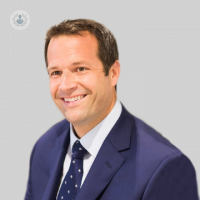Driving after a knee replacement
Written in association with:Wondering how long it will take before you can get back behind the wheel is a common concern for patients awaiting replacement surgery. In the preparation for a knee replacement it's understandably a prevalent question. For anyone who relies on cars to get around, which is many of us, going without one isn’t a comfortable prospect.
How does knee replacement surgery affect your capacity to drive and what tips are useful when it's time to get back behind the wheel? Esteemed orthopaedic surgeon Mr Christopher Arthur Bailey answers these questions and more in our latest article, telling when driving after a knee replacement is recommended.

What does the general guidance say?
There is no exact time frame for someone returning to driving after knee replacement surgery. Following NHS advice, ‘when you can bend your knee enough to get in and out of a car and control the car properly' you can resume driving. You should feel in control of and comfortable in the car at all times, and also be able to perform abrupt movements, like an emergency stop, effortlessly and unrestricted.
When do most people get back to driving after a knee replacement?
The average time to wait to drive following knee replacement surgery is between 6 and 8 weeks. A recent study, that profiled nearly 100 drivers after their operation, showed that 80% were back behind the wheel after a 6 week wait and experienced no negative impact on their driving. Encouragingly, a quarter of people said they actually noticed an improvement. While it may take 6 weeks for some, remember that the waiting period is subjective and depends on the individual case.
What would hold me back?
Knee replacement is a major surgery. Patients are required to remain in hospital for up to three days following the procedure and take pain killers for up to two weeks. Patients are likely to require several weeks off work to recover. Bare this in mind when getting back to driving. For most people, it will take time to familiarize themselves with their new knee. Rebuilding of muscle strength, recovering of reaction times and getting used to bending and walking with a new joint are all parts of the recovery process which will greatly impact the journey back behind the wheel.
How will I know when I’m ready?
It is up to the individual to evaluate their situation, with the help of their physiotherapist, to know whether they're ready or not to be in full and safe control of their car. The Royal College of Surgeons have suggested practicing exercises in a car, without the key in the ignition, to gage mobility and discomfort levels experienced. They suggest practicing moving the foot to and from the pedals, building up the movements slowly and ceasing immediately if there is any pain felt. If pain following the exercise ensues, it's advisable to wait a day or two before trying again. When enough pressure can be applied to the break to perform an emergency stop uninhibited, the patient may consider driving again.
Does driving an automatic car influence waiting time?
Driving an automatic car may sped up recovery time, depending on which knee has been operated on. Drivers of automatic cars mostly make use of their right foot to navigate the accelerator and break. In this instance, if the left knee was operated on, it could reduce the estimated wait time but it's not a guarantee. It will still take considerable time to regain strength and reaction times after the operation.
What else do I need to consider?
Other factors worth considering before the operation:
• Insurance: Some companies don't insure drivers for a certain period of time following their procedure. It's best to check what cover your provider offers.
• Medication: When returning to drive, nobody should be experiencing the sedative effects of painkillers or other medicines which can inhibit reaction speed.
• The DVLA: The Driver and Vehicle Licensing Agency (DVLA) states that they must be informed of operations and if the person is still unable to drive 3 months later. See here for more details.
What should I do about other concerns?
If you’re unsure about anything regarding driving following your knee replacement operation, have a chat with your doctor or physiotherapist. When planning your recovery, they will offer guidance and advice. You can also discuss it with us too, of course; we’ll be happy to help. For more information on the recovery process, you can find other resources, such as this article, on our website: How long does it take to recover from a total knee replacement? A surgeon’s timeline.
If you have concerns about driving again after a knee replacement, or would like more information, you can schedule a consultation with Mr Christopher Arthur Bailey on his Top Doctors profile.


